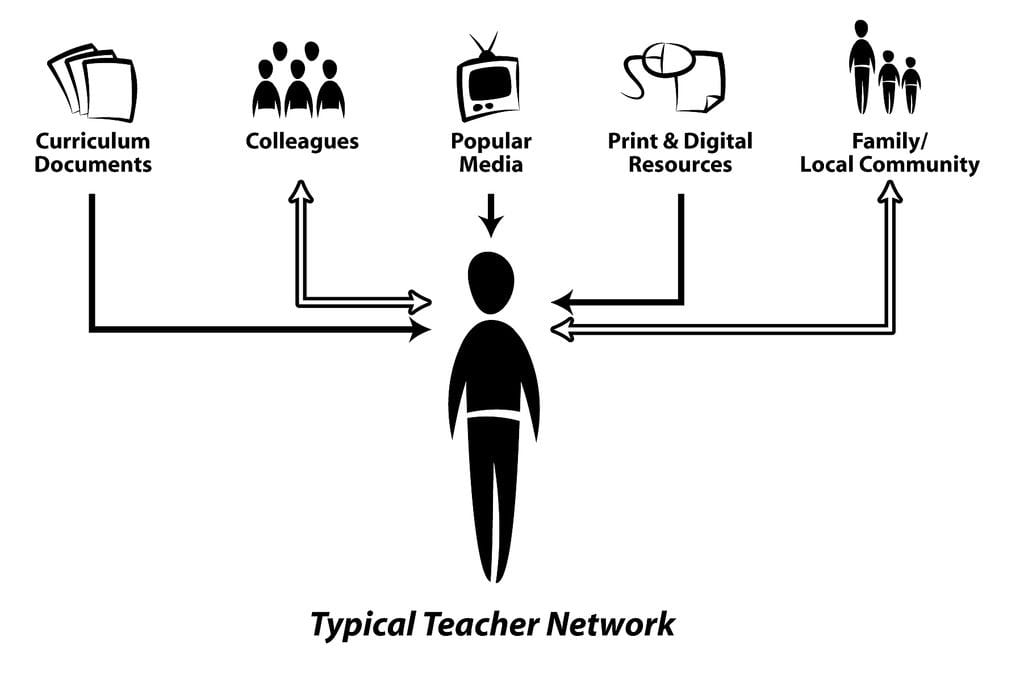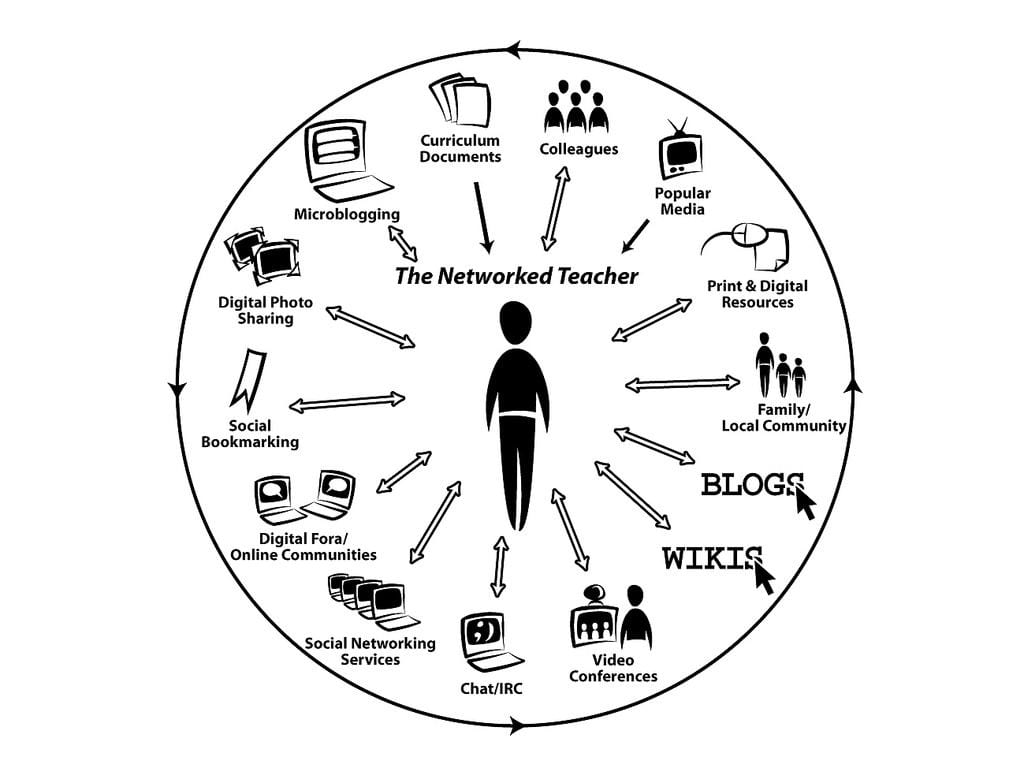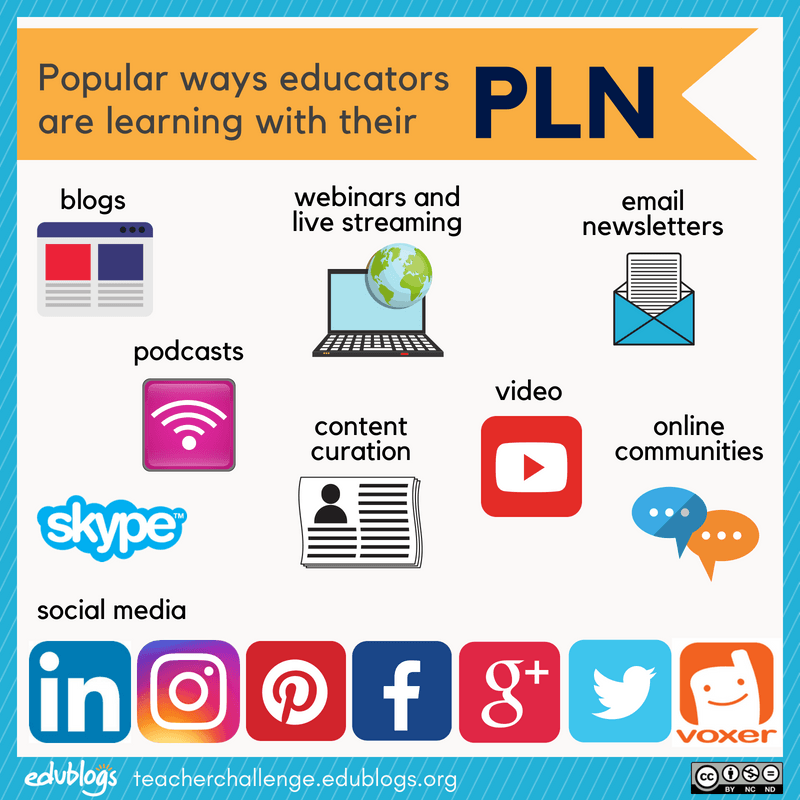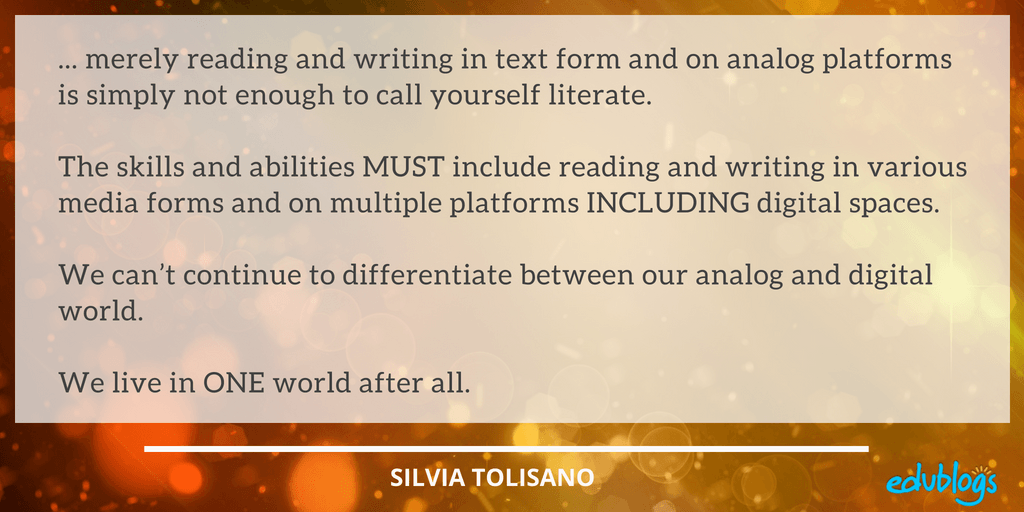Welcome to second step in our free professional learning series on building your PLN.
In the first step, we unpacked the definition of a PLN and looked at the benefits of being a connected educator.
You may now be wondering how to begin building your own PLN.
The aim of this step is to:
- Offer an overview of how to build a PLN
- Provide a snapshot of some tools educators use to connect with their PLN
- Share tips for connecting with educators from around the globe
- Discuss barriers to building a PLN
The Networked Teacher
Around a decade ago, Alec Couros created two diagrams that have been shared thousands of times.
This first diagram demonstrates how a teacher would traditionally connect and learn.

This diagram of “The Networked Teacher” demonstrates just some of the ways that educators can connect now that technology is at their fingertips. Note, the “old” ways of connecting are still there.

Alec’s brother George reminds us that the arrows go back and forth and it’s not only about what you consume but what you create. You can give as well as receive.
What Tools Are Used?
Teachers from all over the globe are online and learning together, but where exactly do you find these teachers and develop working relationships with them?
In a 2016 study called “Together we are better: Professional Learning Networks For Teachers”, K-12 teachers were asked how they use PLNs.
The most popular tool in the sample was Twitter with 53% of participants indicating that they used this tool to connect with others.
Other popular tools listed in the survey included blogs, Edmodo, Facebook, Discovery Education Network, and Pinterest.
84% of survey participants indicated that they use more than one medium or site.
How Are Teachers Connecting On Online Platforms?
Teachers use social media and other online spaces in a variety of ways to connect with their PLN.
Here are ten examples:
- Twitter — Educators follow people they’re interested in, ranging from “thought leaders” to everyday teachers in a similar subject area or age group. Teachers also use hashtags to follow topics of interest, and join Twitter chats to discuss ideas in real time. Be sure to follow Edublogs and CampusPress on Twitter. The next step in this series will explain how to start using Twitter.
- Facebook — Educators follow pages and profiles of people and businesses involved in education. They also join Facebook groups to post questions, ask for feedback, and respond to others. Visit our Edublogs Facebook page and Facebook for Education to start learning something new.
- Instagram — You can follow educators to get new ideas for lessons, activities, learning spaces and more. Hashtags make it easy to search for topics you’re interested in. Check out Tony Vincent’s Guide to Instagram For Teachers.
- Pinterest — Pinterest is ultimately a ‘discovery engine’ and is becoming a go-to for many educators looking for fresh ideas, resources, and connections. Be sure to follow Edublogs on Pinterest!
- Blogs — Blogs play an important role in most educators’ PLNs. This might include reading blogs from a variety of different people or writing your own blog. Visit Step Five of this series for more information.
- Email newsletters — There might be an educator, thought leader, or blogger who you really enjoy following. Chances are, they have an email newsletter that you can subscribe to for free to have curated news and contented delivered straight to inbox!
- Voxer — This walkie-talkie like tool can be used as an app on your mobile device or on your computer. Educators can engage in both synchronous and asynchronous conversations about their professional practice. Learn more in this article on Voxer by Amy Heavin.
- YouTube — Video is a powerful medium. Many teachers enjoy following a selection of YouTube channels to keep up to date with a variety of topics. Check out Kasey Bell’s 20 YouTube Channels for Educators to find some channels that might interest you.
- LinkedIn — Considered a “professional” social networking platform, educators can connect with a large community of professionals on LinkedIn. Explore this collection of 25 LinkedIn groups for networking teachers via Fractus Learning.
Feel free to share this graphic on your blog or with your colleagues.
Tips For Developing Relationships
PLNs are all about relationships! Here are a few tips to consider as you begin to build your PLN.
- Invest some time in building your PLN. Set aside even 15 or 20 minutes a day and you’ll build momentum in no time.
- PLNs work both ways. Remember, the more you share, the more you’ll find you receive in return.
- Try different tools. There are so many different forms of social media, online tools, and ways to connect. Dip your toes in and see how educators are using various tools.
- Find tools that work best for you. While it’s definitely worth giving things a try, not every platform is for everyone. Choose to dedicate time to the tools you enjoy and find the most rewarding.
- Follow up with people. If someone connects with you whether it’s through a tweet, blog comment, Facebook group, or any platform, thank them, ask a question, and get to know them. These are the building blocks of forming a relationship.
- Ask for help. If you find someone who already has a number of connections (on Twitter, Instagram, Facebook, or wherever) ask them to introduce you to others. Don’t be afraid to ask for help when you’re figuring out how various platforms work either.
- Curate wisely. If you want to share interesting resources with people in your PLN, make sure you read beyond a headline and share things you think will be truly useful.
- Diversify. Try to connect with people with diverse opinions and points of view. It’s easy for “birds of a feather to flock together”, however, sometimes there is more to gain from communicating with a range of people from different backgrounds.
- Involve your students. Once you get to know a few educators, you might start to think about ways you can connect your students. Check out our Edublogger’s Guide To Global Collaboration for lots of ideas.
- Spread the word. As you begin to explore PLNs and online communities, share this information with others in your school or district. Maybe they don’t realize this wonderful virtual opportunity exists!
Barriers To Creating A PLN
In our first step, we looked at many of the advantages of building a PLN. If the benefits of being a connected educator are clear, what holds so many teachers back from building their own PLN?
Perhaps the first obstacle is that many teachers simply don’t know about PLNs. They don’t know there are thousands of educators from around the world who are online connecting, collaborating, and learning together.
Furthermore, Tom Whitby has outlined three deterrents to educators using PLNs as a tool for ongoing learning.
The PLN is a mindset, not the outcome of a workshop or the PD offered annually by many school districts. It is not a one-shot fix.
Teachers have learned through the “sit and get” model for generations. This mindset shift where you need to realize that you are responsible for your own learning and you can take control can be difficult to adapt to.
Additionally, prioritizing the investment in time that building a PLN requires would certainly be an obstacle for some. Step seven in this series offers some tips on finding time to invest in your PLN.
Successful users of PLNs overwhelm the uninitiated with techno-babble.
Hopefully, the future steps in this course can break down any overwhelming “techno-babble”.
You will probably find that many teachers who are regular uses of online technologies proclaim that they are “not very tech savvy”. Even George Couros who has a Twitter following of 224,000+ has said, “I’m not that good with technology and you probably aren’t either“.
It requires, at least at first, digital literacy beyond a Google search.
It is certainly essential that educators develop their digital literacy. As Silvia Tolisano has pointed out, our notion of what it means to be literate or illustrate calls for an update.
If you feel like you need to improve your own digital literacy skills, don’t despair! You don’t need to learn everything before you embark on building your PLN. We will provide you with the essential tips and skills throughout this course and you can learn as you go.
If you feel like your skills need updating in other areas, such as blogging and online tools, we have other free courses you can work through at your own pace too.
Conclusion
Becoming a connected educator is something that takes work but has enormous advantages for both you and your students. In fact, many educators would say that it’s an essential responsibility of teachers to connect and commit to lifelong learning.
As George Couros has said, “Isolation is now a choice educators make“.
There are so many ways to free yourself from isolation. The following steps in this series breaks down three powerful avenues to becoming a connected educator — Twitter, blogs, and content curation.
Your Task
We’d like you to add your voice and ideas to our ongoing conversation on building your own PLN by undertaking one or more of the following challenges:
- Preferences: We all enjoy connecting in different ways. Write a post or comment on this post about how you plan to connect with other educators. What sites or tools do you think you’d prefer to use to make connections. Why?
- Relationship tips: Revise our list of tips for developing working relationships with other educators. What resonates most with you? Do you have any ideas to add? Tell us in a comment.
- Barriers: We have identified some common barriers to building a PLN. Leave a comment and tell us what the biggest barrier has been for you (or others you know). Share your thoughts on how this obstacle can be overcome.
Also feel free to leave a comment to ask any questions or share your tips.
How to leave a comment: Scroll down to find the comment box. Write your comment, then enter your name and email address (email addresses are not published). Enter the anti-spam word. Press submit and we will moderate your comment ASAP.

